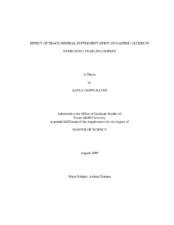| dc.description.abstract | Equine gastric ulcer syndrome (EGUS) has been reported to occur in 40% to over
90% of horses across multiple equestrian disciplines. The objective of this study was to
evaluate the effect of trace mineral supplementation on gastric ulcers in exercising
yearling horses. Twenty-one Quarter Horse yearlings, 15 to 18 mo of age, were
randomly assigned to 1 of 3 treatment groups. The control group received no
supplemental trace minerals, the inorganic group received supplemental sulfated trace
minerals, and the organic treatment received supplemental amino acid complexed trace
minerals. The trial consisted of 3 consecutive 28-d periods, separated by 5 d of diet
acclimation. The basal ration included a 14% CP textured concentrate, with coastal
Bermudagrass hay fed in Periods 1 and 3 and alfalfa consumed in Period 2. In Periods 1
and 2, horses were exercised on a mechanical horse-exerciser, but were lunged or
underwent training in an undergraduate course in Period 3. At the end of each period,
horses were transported for 6 h, 5 d before being endoscopically examined to assign
ulcer scores. Data were analyzed as repeated measures using the mixed procedure of SAS, with the model including fixed effects of treatment, period, and their interaction
(SAS 9.2). All P-values < 0.05 were considered significantly different.
Baseline EGUS scores were not different among treatment groups, with a mean
of 2.1. There was no effect of treatment in any period, or a period by treatment
interaction. There was a significant period effect (P < 0.01). Mean ulcer scores in
Periods 1, 2, and 3 were significantly lower than baseline, with mean scores of 1.5, 1.0,
and 1.5, respectively. There was a tendency (P=0.06) for mean ulcer scores to be lower
in Period 2 than in Periods 1 and 3, which were not different. Average daily intakes of
Zn, Mn, Cu, and Co were significantly higher in the organic and inorganic than control
horses (P < 0.0001).
Under the conditions of this study, trace mineral supplementation did not affect
gastric ulcer appearance and severity. However, it is possible that dietary and
management alternatives, such as hay and concentrate types, could be anti-ulcerogenic. | en |


